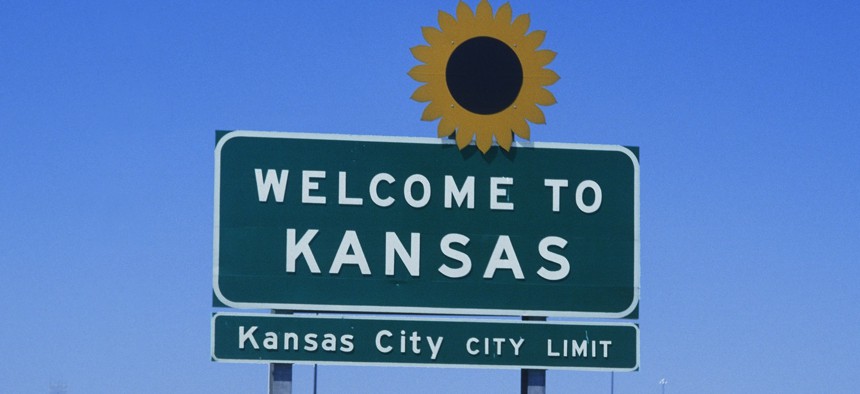Comparing Kansas to Its Neighbors

Welcome to Kansas. Joseph Sohm / Shutterstock.com

Connecting state and local government leaders
Personal income estimates slid downward in 57 of the Sunflower State's 105 counties in 2014. But adjacent states didn't see similar declines.
Amid an off year for the state's farmers, personal income sank in over half of the counties in Kansas during 2014, according to estimates released last week by the U.S. Bureau of Economic Analysis.
In 57 of the state’s 105 counties, personal income fell last year compared to 2013, the data, published Thursday, show. Income slid by an estimated 10 percent or more in 21 of the counties that saw declines.
Some of the steepest drops occurred in heavily agricultural areas in the western half of the state.
Agriculture is a big deal in Kansas. Combined with the food and food-processing sectors, it will account for about 43 percent of the state's economy in 2015, according to projections published in May by the Kansas Department of Agriculture.
But, last year, the farming business in the state was financially lean. Figures from the U.S. Department of Agriculture show that net cash income for farms in Kansas plunged from just over $6.1 billion in 2013, to around $3.7 billion in 2014, which tracks with the personal income declines in the new Bureau of Economic Analysis estimates.
The declines in personal income in Kansas last year were not mirrored on a comparable scale in any of the four states it borders—Colorado, Missouri, Nebraska and Oklahoma.
They also occurred against the backdrop of huge state tax cuts that Republican Gov. Sam Brownback signed in 2012, with the aim of spurring economic growth in the Sunflower State.
Since the cuts were enacted, Kansas has experienced significant tax revenue shortfalls. And the tax-slashing regimen continues to face criticism from those who argue that it has failed to stimulate the state's economy.
In addition to showing year-to-year changes in personal income, the Bureau of Economic Analysis data also includes per-capita personal income estimates for each county—a measure of the total personal income in a place divided by the number of people residing there.
The median per-capita income across all of the counties in Kansas was $41,680 in 2014, down from $43,665, the prior year.
By comparison, estimated per-capita income for the entire United States in 2014 was $46,049. Among Kansas’ neighbors the county-level medians looked like this: Colorado ($40,297), Missouri ($35,037), Nebraska ($48,088) and Oklahoma ($37,195).
The Bureau of Economic Analysis defines personal income as “the income received by, or on behalf of, all persons from all sources.” Some of those sources might include salaries, wages, rental or business income, or interest from financial assets. In the data, income is measured before income taxes and other personal taxes are deducted.
The following maps offer a look at the personal income estimates for Kansas and the states that surround it.
In this first map is the estimated percent change in personal income in 2014, compared to 2013, for each of the counties in the state.

Wallace County, on the western edge of Kansas, saw the biggest downward percent change in personal income of any county in the state last year, at 32.7 percent. Estimated per-capita income there dropped from $67,225 in 2013 to $45,224 in 2014.
Farming is an important part of the local economy in Wallace County.
There are 913 square miles in the county, or roughly 584,730 acres. About 173,936 acres of this land—around 30 percent—were harvested in 2012, based on information from the Institute for Policy & Social Research at the the University of Kansas. The county has a population of about 1,500 people and, according to the Institute for Policy & Social Research, the source for just over half of the personal income in the county in 2011 came from farm proprietorship.
The counties that contained the biggest cities in Kansas fared better than many of their more rural counterparts. Sedgwick County, where Wichita is located, saw mild growth in personal income, checking in at an estimated 2.3 percent. Likewise, in Wyandotte County, home of Kansas City, the figure was 2.5 percent. And in Shawnee, where Topeka is the county seat, it was 2.7 percent.
This next map shows what the percent changes in personal income in Kansas looked like prior to 2014, between 2012 and 2013.
It’s a rosier picture. Only 15 counties experienced personal income declines. The trends, here again, are in line with what was happening with farms in the state. Net cash income from farming, according to the U.S. Department of Agriculture, went from around $4.6 billion in 2012, upwards to the $6.1 billion total recorded in 2013.

And, finally, here are the dollar figures for per-capita personal income estimates in each county in Kansas last year.

This next series of maps shows estimated changes in personal income between 2013 and 2014 for counties in the four states that border Kansas. The declines in personal income in these states were not as widespread, or as severe, as those in Kansas.


Although 34 counties in Nebraska experienced declines in estimated personal income, in only two of these places were the decreases greater than 10 percent.


In this final series of maps are per-capita personal income estimates for each of the surrounding four states in 2014.




All of the data released by the Bureau of Economic Analysis last week can be found here.
Bill Lucia is a Reporter for Government Executive's Route Fifty.

NEXT STORY: NYC builds out subway Wi-Fi access





